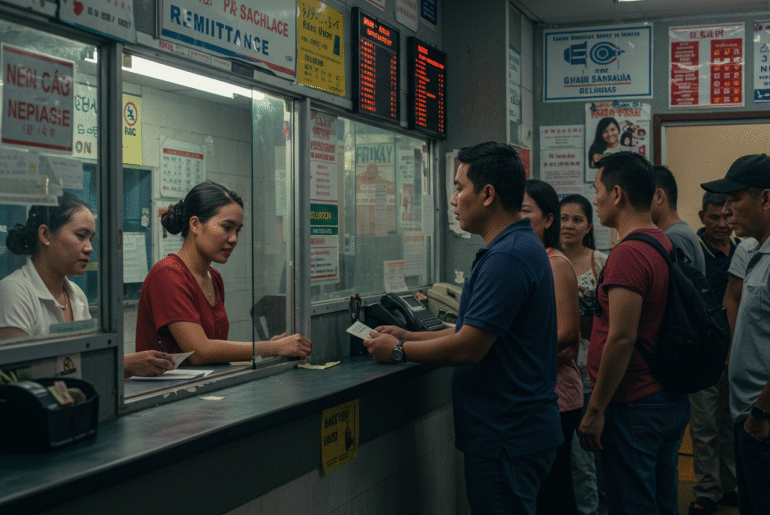This article may contain references to products or services from one or more of our advertisers or partners. We may receive compensation when you click on links to those products or services. Nonetheless, our opinions are our own.
The information presented in this article is accurate to the best of our knowledge at the time of publication. However, information is subject to change, and no guarantees are made about the continued accuracy or completeness of this content after its publication date.
Key Highlights
- Remittances significantly impact the global economy, providing more support to developing nations than traditional foreign aid.
- Emerging technologies such as blockchain and digital platforms are enhancing the speed and reducing the cost of money transfers.
- High transaction fees remain a major challenge, especially for cross-border payments between developing countries.
- According to the International Monetary Fund and the World Bank, remittances contribute meaningfully to the economic resilience of vulnerable states.
- Evolving migration patterns and concerns regarding illicit finance are prompting new regulations in international money transfer services.
Introduction
Remittance flows refer to monetary transfers, primarily from migrant workers residing abroad, sent to their home countries. These funds are essential components of global financial systems and often exceed international aid in many developing nations. Remittances contribute to improved access to education, healthcare, and infrastructure for recipient families. The integration of digital technologies has further streamlined the remittance process, making it faster, safer, and more accessible worldwide.
Understanding Remittance: An Overview
Remittances involve sending money from one country to another, typically by migrant workers supporting their families back home. These transfers are used to cover essential expenses, including food, education, and healthcare. Recently, global remittance flows have increased due to rising migration and advances in financial technology. According to the World Bank, remittances are pivotal in boosting local economies and enhancing community resilience in developing regions.
What is Remittance?
Remittance is the transfer of funds from one person to another, usually from a worker to their family. These financial transfers are crucial for meeting daily needs such as housing, food, and education. Banks, mobile applications, and companies like Western Union facilitate these transactions. International organizations recognize remittances as more effective than foreign aid in promoting financial stability and economic development in recipient countries.
Importance of Remittance in the Global Economy
Remittances play a vital role in fostering global economic stability. In many lower-income nations, remittance flows surpass foreign direct investment and official development assistance. These funds offer households a reliable source of income, helping them access healthcare, improve educational opportunities, and enhance living conditions. Governments are also working to lower remittance costs and expand access to secure financial services, thereby encouraging sustained economic development.
The Evolution of Remittance Services
Historically, remittances relied on manual processes such as bank drafts and wire transfers, often resulting in high fees and processing delays. Today, financial innovations—including digital wallets, mobile applications, and blockchain—are revolutionizing the industry. These technologies reduce costs and promote financial inclusion by offering accessible and transparent services to underserved populations.
Traditional Methods vs. Modern Solutions
Traditional remittance methods involved banks and postal services, often burdened by inefficiencies, long wait times, and expensive fees. These challenges were particularly pronounced in developing nations with limited financial infrastructure. Modern technologies such as digital wallets, fintech apps, and blockchain solutions are addressing these barriers. These tools offer affordability, speed, and transparency, expanding access to financial services for migrant workers and their families.
How Technology is Reshaping Remittance
Technological advancements are transforming global remittance systems. Established institutions and startups now use digital frameworks to lower costs and enhance user experience. Blockchain and digital currencies reduce fraud risks and ensure transaction integrity. Compliance with international financial regulations strengthens global trust, while user-friendly platforms simplify access to secure remittance channels.
Voted "Best Overall Budgeting App" by Forbes and WSJ
Monarch Money helps you budget, track spending, set goals, and plan your financial future—all in one app.
Get 50% OFF your first year with code MONARCHVIP
Beginner’s Guide to Sending Remittances
Necessary Preparations: What You’ll Need
Before initiating a money transfer, gather essential recipient details such as full name, physical address, and banking or mobile wallet information. Verifying this data minimizes processing errors. Familiarity with financial regulations, including anti-money laundering and balance of payments guidelines, is important. Choose licensed, reputable service providers to ensure safe and compliant transactions.
Step-by-Step Guide/Process
Step 1: Choosing Your Remittance Service Provider
Select a provider based on reputation, cost, delivery speed, and regulatory compliance. Options include traditional companies like Western Union and digital platforms such as WorldRemit. Compare service fees, exchange rates, and processing times.
Step 2: Setting Up Your Account
Create an account with the selected provider. Submit identification documents and link a payment method. Ensure the provider meets financial safety standards to protect personal and transactional data.
Step 3: Transaction Process
Enter the recipient’s details and transfer amount. Please ensure all data is accurate before proceeding. Transparent platforms disclose applicable fees and rates before completing the transaction. Please keep the receipt for your records.
Step 4: Tracking and Receiving Confirmation
Use the transaction ID to monitor progress through mobile applications or websites. Both sender and recipient can track the status. Upon completion, a confirmation will reflect the amount received and any associated charges.
Key Factors Influencing Remittance Trends
Economic Stability and its Impact
Macroeconomic conditions in sending and receiving countries directly influence remittance flows. A stable economy supports lower costs and increased remittance volumes, whereas instability may disrupt transfers and elevate fees. Factors such as GDP growth, inflation, and employment rates affect remittance behavior. In economically challenged regions, these funds provide essential support for local development.
Migration Patterns and Their Effects
Migration trends strongly impact remittance flows. Countries with high emigration rates often experience greater inflows. These financial transfers contribute significantly to local economies and support family livelihood. Current migration patterns show robust remittance inflows to countries like India, Mexico, and several African nations. These funds play a strategic role in economic planning and social development.
Regional Focus: Money Sent and Received to and from the US
Major Destinations for US Remittances
Mexico, India, China, and the Philippines are among the top recipients of remittances from the United States. These funds represent a substantial portion of GDP in many recipient countries and support national economic stability. Regions including Latin America and sub-Saharan Africa rely heavily on remittances, emphasizing the importance of affordable, reliable transfer options.
Trends in Remittance Sources within the US
The diversification of immigrant communities in the United States is reshaping remittance flows. Communities from Southeast Asia and Africa are emerging as significant contributors. Remittance providers are expanding digital offerings and reducing service charges to meet the needs of these evolving markets. Innovations continue to improve accessibility and delivery efficiency.
Conclusion
Trends in remittance reflect the integration of technological innovation, demographic shifts, and policy reforms. These monetary transfers support household welfare and foster national economic growth in developing nations. Continued advancements in regulation and financial infrastructure are enhancing the efficiency and security of remittance systems. As global cooperation improves, remittances will remain integral to reducing inequality and promoting financial inclusion worldwide.
Frequently Asked Questions
What are the normal charges for sending money transfers?
Fees vary by provider and service type. Some charge a fixed fee, while others take a percentage of the transaction amount. Additional costs may include currency conversion and service add-ons. Comparing multiple providers can help minimize expenses.
Could you please let me know how long it typically takes for a money transfer to be completed?
Transfer time depends on the provider, payment method, and destination. Some transfers are completed within minutes, while others may take several days. Processing regulations and recipient banking systems can also affect timing.
Are remittances taxed in the United States?
Remittances are generally not considered taxable income in the United States. However, large or frequent transfers may require reporting. Consulting a tax advisor ensures compliance with applicable tax laws.
What information is required to send a remittance?
Senders must typically provide the recipient’s full name, address, and banking or mobile wallet details. Identification and a valid payment method are also required to complete the transaction securely.

Reviewed and edited by Albert Fang.
See a typo or want to suggest an edit/revision to the content? Use the contact us form to provide feedback.
At FangWallet, we value editorial integrity and open collaboration in curating quality content for readers to enjoy. Much appreciated for the assist.
Did you like our article and find it insightful? We encourage sharing the article link with family and friends to benefit as well - better yet, sharing on social media. Thank you for the support! 🍉
Article Title: Emerging Trends in the Future of Remittance
https://fangwallet.com/2025/05/13/future-of-remittance/The FangWallet Promise
FangWallet is an editorially independent resource - founded on breaking down challenging financial concepts for anyone to understand since 2014. While we adhere to editorial integrity, note that this post may contain references to products from our partners.
The FangWallet promise is always to have your best interest in mind and be transparent and honest about the financial picture.
Become an Insider

Subscribe to get a free daily budget planner printable to help get your money on track!
Make passive money the right way. No spam.
Editorial Disclaimer: The editorial content on this page is not provided by any of the companies mentioned. The opinions expressed here are the author's alone.
The content of this website is for informational purposes only and does not represent investment advice, or an offer or solicitation to buy or sell any security, investment, or product. Investors are encouraged to do their own due diligence, and, if necessary, consult professional advising before making any investment decisions. Investing involves a high degree of risk, and financial losses may occur including the potential loss of principal.
Source Citation References:
+ Inspo
There are no additional citations or references to note for this article at this time.












































